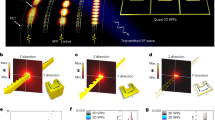Abstract
The threats to civil society posed by high-power electromagnetic weapons are viewed as a grim but real possibility in the world after 11 September 2001 (refs 1–3). These weapons produce a power surge capable of destroying or damaging sensitive circuitry in electronic systems. Unfortunately, the trend towards circuits with smaller sizes and voltages renders modern electronics highly susceptible to such damage. Radiofrequency communication systems are particularly vulnerable, because the antenna provides a direct port of entry for electromagnetic radiation. Here, we report a type of radiofrequency receiver front end featuring a complete absence of electronic circuitry and metal interconnects, the traditional ‘soft spots’ of a conventional radiofrequency receiver. The device exploits a dielectric resonator antenna to capture and deliver the radiofrequency signal onto an electro–optic field sensor. The dielectric approach has an added benefit in that it reduces the physical size of the front end, an important benefit in mobile applications.
This is a preview of subscription content, access via your institution
Access options
Subscribe to this journal
Receive 12 print issues and online access
$209.00 per year
only $17.42 per issue
Buy this article
- Purchase on Springer Link
- Instant access to full article PDF
Prices may be subject to local taxes which are calculated during checkout





Similar content being viewed by others
References
Special Issue on High-Power Electromagnetics (HPEM) and Intentional Electromagnetic Interference (IEMI). IEEE Trans. EMC 46, 314–321 (2004).
Abrams, M. Dawn of the e-bomb. IEEE Spectrum 40, 24–30 (2003).
U.S. Congress. Report of the Commission to Assess the Threat to the United States from Electromagnetic Pulse (EMP) Attack, Vol. 1, Executive Report (2004), http://www.globalsecurity.org/wmd/library/congress/2004_r/04-07-22emp.pdf
Gong, K., Feng, H., Zhan, R. & Wang, A. Z. H. A study of parasitic effects of ESD protection on RF ICs. IEEE Trans. Microwave Theory Technol. 50, 393–402 (2002).
Ilchenko, V. S., Savchenkov, A. A., Matsko, A. B. & Maleki, L. Sub-microwatt photonic microwave receiver. IEEE Photon. Technol. Lett. 14, 1602–1604 (2002).
Ilchenko, V. S., Savchenkov, A. A., Matsko, A. B. & Maleki, L. Whispering-gallery-mode electro-optic modulator and photonic microwave receiver. J. Opt. Soc. Am. B 20, 333–341 (2003).
Cohen, D. A., Houssein-Zadeh, M. & Levi, A. F. J. Microphotonic modulator for a microwave receiver. IEE Electron. Lett. 37, 300–301 (2001).
Cohen, D. A. & Levi, A. F. J. Microphotonic components for a mm-wave receiver. Solid State Electron. 45, 495–505 (2001).
Hossein-Zadeh, M. & Levi, A. F. J. 14.6-GHz LiNbO3 microdisk photonic self-homodyne RF receiver. IEEE Trans. Microwave Theory Tech. 54, 821–831 (2006).
Tazawa, H. et al. Ring resonator-based electrooptic polymer traveling-wave modulator. IEEE J. Lightwave Technol. 24, 3514–3519 (2006).
Dettmer, R. Dielectric antenna make waves. IEE Rev. 49, 28–31 (2003).
Petosa, A., Ittipiboon, A., Antar, Y. M. M., Roscoe, D. & Cuhaci, M. Recent advances in dielectric resonator antenna technology. IEEE Trans. Antennas Propag. 40, 35–48 (1998).
Long, S. A., McAllister, M. & Shen, L. C. The resonant cylindrical dielectric cavity antenna. IEEE Trans. Antennas Propag. 31, 406–412 (1983).
Mongia, R. K. & Bhartia, P. Dielectric resonator antennas – a review and general design relations for resonant frequency and bandwidth. Int. J. Microwave Millimeter-Wave Computer-Aided Engineering 4, 230–247 (1991).
Institute of Electrical and Electronic Engineers, IEEE standard methods for measuring electromagnetic field strength of sinusoidal continuous waves, 30 Hz to 30 GHz no. IEEE Std 291-1991, (IEEE, New York, 1991).
Panteny, S., Stevens, R. & Bowen, C. R. Characterisation and modelling of barium titanate–silver composites. Integr. Ferroelectr. 63, 131–135 (2004).
Tamir, T. Guided-Wave Optoelectronics (Spring-Verlag, Berlin, Heidelberg, 1988).
Acknowledgements
This work was supported by DARPA and the U.S. Army. We are grateful to L. Maleki of the Jet Propulsion Laboratory for providing the LiNbO3 microdisk resonator, and to W. Steier of USC, Tatsuo Itoh and D. Solli of UCLA for helpful discussions.
Author information
Authors and Affiliations
Corresponding author
Ethics declarations
Competing interests
The authors declare no competing financial interests.
Rights and permissions
About this article
Cite this article
Hsu, R., Ayazi, A., Houshmand, B. et al. All-dielectric photonic-assisted radio front-end technology. Nature Photon 1, 535–538 (2007). https://doi.org/10.1038/nphoton.2007.145
Received:
Accepted:
Published:
Issue Date:
DOI: https://doi.org/10.1038/nphoton.2007.145
This article is cited by
-
Integrated microcavity electric field sensors using Pound-Drever-Hall detection
Nature Communications (2024)
-
Dual-band dielectric light-harvesting nanoantennae made by nature
Applied Physics A (2019)
-
Microwave Photonic Detector for Measuring Pulsed Electric Field Strengths in the Sub-Nanosecond Region
Measurement Techniques (2018)
-
Magnetic and electric coherence in forward- and back-scattered electromagnetic waves by a single dielectric subwavelength sphere
Nature Communications (2012)
-
Optical cleaning of congruent lithium niobate crystals
Nature Photonics (2009)



